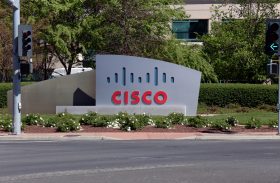Despite 'Beat,' Cisco's Growth Is Slowing

Media headlines and pundits pointed to Cisco's earnings as one of the reasons behind a strong rally in tech shares today, as major market indices bounced back after last week's disastrous plunge. But a more detailed look at Cisco's earnings for its third quarter of fiscal year 2019 indicates that the company's growth rate in key areas is slowing and that there are still major problem areas such as the service-provider market.
It its third fiscal quarter of the year ending in March, Cisco reported revenue growth of 4% year-over-year (y/y), beating most analyst estimates by a hair. Orders also grew 4%. The tech bellwether reported earnings of $0.81 per share, a penny better than consensus analyst estimates, which is where Cisco has tried to report for all of eternity. The company also boosted revenue guidance to 4.5%-6.5% y/y growth.
Company executives reference the trade war but mentioned that they have seen little effect so far. Bear in mind that Cisco may actually benefit from some aspects of the trade war, given the now-official ban on gear from competitor Huawei. That is a tailwind. It also has relatively low China sales.
Slowing Enterprise Growth
If you look below the surface, however, Cisco is not exactly booming, and some numbers have come down. Order growth is 4%, while it was up 8% in the past two quarters, points out Michael Genovese, analyst with MKM Partners. Cisco benefited from the bounce-back in government orders following the government shutdown chaos of late 2017/early 2018, but that bump is now starting to wane. Public Sector order growth slowed to 10%, compared to up 18% in the prior quarter. Enterprise orders were up 9%, versus up 11% in 2QFY19. And commercial order growth was 5% y/y, compared to 7% in 2QFY19.
So, it's clear that after having a robust year in 2019, Cisco's growth rate is slowing. This makes sense, considering that 2018 was the year when the tax stimulus took hold in corporate America, while the tensions with China started rising later in the year. We still don't know what the effect of the trade war will be on Cisco going forward, though it is less exposed to China than most technology companies -- and could actually benefit from this week's official ban on Huawei gear.
Service Provider Headaches
Meanwhile, Cisco's perennial problem child, the service-provider market, still looks like a mess. Service Provider orders declined 13% y/y in the quarter, versus down 1% in the previous period -- indicating an accelerating decline. The long-held fear that generic "white box" hardware sales could ding Cisco's networking gear appears to be starting to take hold, as major North American service providers such as Verizon and AT&T pursue more aggressive plans to build their own networks using white boxes.
Some other highlights from the quarter:
Cash and Cash Equivalents and Investments: Cisco held $34.6 billion at the end of the third quarter of fiscal 2019, compared with $40.4 billion at the end of the second quarter of fiscal 2019, and compared with $46.5 billion at the end of fiscal 2018.
Capital Allocation: Cisco returned $7.5 billion to shareholders through share buybacks and dividends. The company declared and paid a cash dividend of $0.35 per common share, or $1.5 billion, and repurchased approximately 116 million shares of common stock under its stock repurchase program at an average price of $52.14 per share for an aggregate purchase price of $6.0 billion. The remaining authorized amount for stock repurchases under the program is $18.0 billion with no termination date.
Acquisitions: In the third quarter of fiscal 2019, Cisco closed the acquisitions of Luxtera, Inc., a privately held semiconductor company, and Singularity Networks, a privately held network infrastructure analytics company.

















